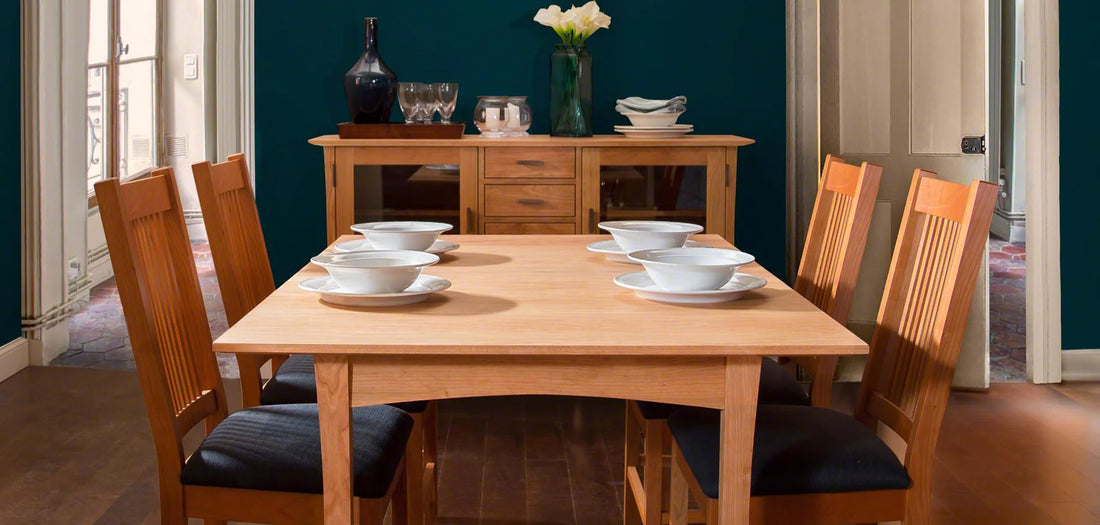If the name Gustav Stickley sounds familiar, it may be because Stickley is one of the most recognizable names in American furniture.
Gustav Stickley (1858-1942) was a furniture maker, visionary designer, and influential publisher that was a key driving force in bringing the Arts and Crafts movement to America in the early 1900s.
His furniture work largely included what has become known as Mission Style Furniture—although, Stickley himselft detested the term and preferred the moniker “Craftsman Furniture.”
The Arts & Crafts Movement of the Early 1900s
In the 1890s, New England furniture craftsman Joseph McHugh coined the term “Mission Style Furniture.”
However, it was Gustav Stickley that made this an American household style. The rapid expansion of the Arts and Crafts movement in the US between the 1900s and the first World War was heavily in thanks to Stickley’s furniture designs and his magazine, The Craftsman.
The Arts and Crafts style eventually gave way to the contrastingly ornamental Art Deco in the early 1930s. But thanks to a resurgence in popularity in the 80s, Mission Style Furniture is still highly sought after today.
The Craftsman Magazine
In 1901, Stickley founded the magazine The Craftsman. This publication contributed to the public’s understanding of the Arts and Crafts aesthetic and the philosophy that was attached to it. It focused on quality, simplicity, transparency, and practicality, without sacrificing quality or beauty. It also frequently encouraged readers to create their own decor.
The magazine ran its last issue in 1916. Want to look inside? Read issues of The Craftsman online.
Gustav Stickley’s Design Philosophy
 Our American Mission collection is a modern day reflection of the ideals of the American Craftsman movement and mission style furniture- exposed joinery, metal loop drawer pulls, and accentuated wood grain.
Our American Mission collection is a modern day reflection of the ideals of the American Craftsman movement and mission style furniture- exposed joinery, metal loop drawer pulls, and accentuated wood grain.
Simplicity, honesty, truth.
“Ala Ik Kon”—which loosely translates to “the best of my ability”— guided Stickley’s approach to furniture and became his company’s trademark.
He envisioned inornate, quality furniture that was admired not for its prestigious or fancy materials, but beautiful construction. He rejected the subpar quality of furniture made through industrialization.
While his company eventually used factories to produce chairs to keep up with demand, they were still hand assembled and finished by craftsmen. This was a compromise that allowed the furniture to be readily available without sacrificing quality.
Gustav Stickley Furniture
 A credenza by Gustav Stickley. A prominent wood grain, like seen here, is found in much of his work. By Sailko - Own work, CC BY 3.0, (Image)
A credenza by Gustav Stickley. A prominent wood grain, like seen here, is found in much of his work. By Sailko - Own work, CC BY 3.0, (Image)
It was in the first years of the 1900s that Stickley would produce the furniture that he is most commonly associated with—heavy, high-quality Ash and Oak pieces that are simple and substantial.
In his later years of design, though, you will find more airy and modern furniture that coincided with market demands at the time, some of which included metal inlays. These metal inlays surprise many since they contrast Stickley’s usual inornate designs, but this is what consumers wanted.
Stickley defended this unexpected addition to his work in The Craftsman magazine by stating that these designs “came from within.” However, these inlay designs only lasted a short time before they became reserved for special orders.
Typical characteristics associated with Stickley’s furniture include:
- Clean lines
- Heavy or “chunky” design
- Unadorned
- Solid wood, especially Oak
- Quartersawn wood
- Unobscured wood grain
- Leather or canvas upholstery
- Pinned mortise and tenon joinery
- Dovetail joints
Did you know: Not all furniture labeled “Stickley” is designed by Gustav Stickley. There were 11 children in the family, and 4 of his brothers were also in the furniture business. Today all of their designs have been merged into one company, Stickley.
American Craftsman Homes

“It comes to me every day of my life that a home spirit is being awakened amongst us, that as a nation we are beginning to realize how important it is to have homes of our own, homes that we like, that we have been instrumental in building, that we will want to have belong to our children.” – Gustav Stickley, More Craftsman Homes (1912)
Although architect Harvey Ellis died only a few months after being hired by Gustav in 1903, he had a profound impact. Ellis elevated The Craftsman magazine’s architectural offerings and highlighted the synergies between Stickley’s work and that of English and Glaswegian designers, which eventually lead to the Craftsman Home Builders Club being formed.
The Craftsman Home Builders Club provided Arts and Crafts-inspired architectural plans through the magazine in familiar styles such as cottage, farmhouse, and bungalow—to name a few. The homes offered were designed to harmonize with the landscape by using natural materials and soft colors. By the time the magazine’s run ended, there were more than 222 home plans available, officially putting Craftsman homes on America’s radar.
Later, the originality and artistic quality of these Craftsman homes would pave the way for Art Deco, as well as inspire Frank Lloyd Wright to become an innovator of the Prairie School of architecture and design.
Thanks to their quality, versatility, and timelessness, Gustav Stickley’s furniture is still in demand over a century later. His designs can be found in numerous homes and showrooms across the country.
Read more about mission & craftsman design, or shop our craftsman style furniture.


